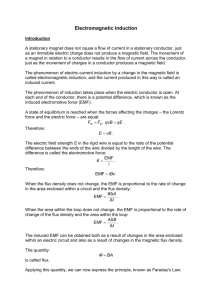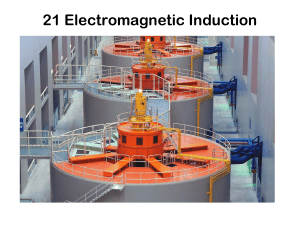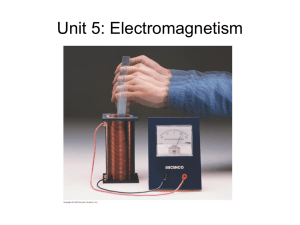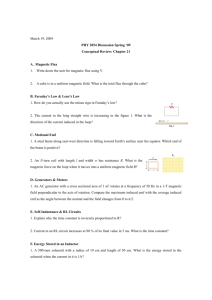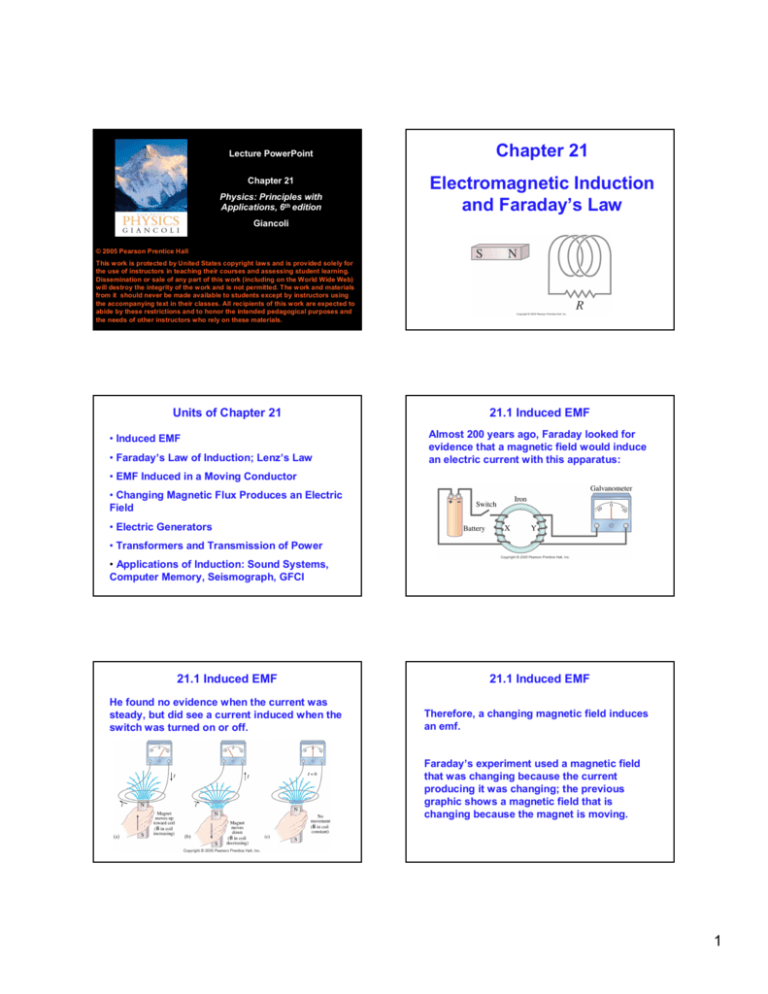
Lecture PowerPoint
Chapter 21
Physics: Principles with
Applications, 6th edition
Chapter 21
Electromagnetic Induction
and Faraday’s Law
Giancoli
© 2005 Pearson Prentice Hall
This work is protected by United States copyright laws and is provided solely for
the use of instructors in teaching their courses and assessing student learning.
Dissemination or sale of any part of this work (including on the World Wide Web)
will destroy the integrity of the work and is not permitted. The work and materials
from it should never be made available to students except by instructors using
the accompanying text in their classes. All recipients of this work are expected to
abide by these restrictions and to honor the intended pedagogical purposes and
the needs of other instructors who rely on these materials.
Units of Chapter 21
• Induced EMF
• Faraday’s Law of Induction; Lenz’s Law
21.1 Induced EMF
Almost 200 years ago, Faraday looked for
evidence that a magnetic field would induce
an electric current with this apparatus:
• EMF Induced in a Moving Conductor
• Changing Magnetic Flux Produces an Electric
Field
• Electric Generators
• Transformers and Transmission of Power
• Applications of Induction: Sound Systems,
Computer Memory, Seismograph, GFCI
21.1 Induced EMF
He found no evidence when the current was
steady, but did see a current induced when the
switch was turned on or off.
21.1 Induced EMF
Therefore, a changing magnetic field induces
an emf.
Faraday’s experiment used a magnetic field
that was changing because the current
producing it was changing; the previous
graphic shows a magnetic field that is
changing because the magnet is moving.
1
21.2 Faraday’s Law of Induction;
Lenz’s Law
The induced emf in a wire loop is proportional
to the rate of change of magnetic flux through
the loop of cross-sectional area A.
Magnetic flux:
21.2 Faraday’s Law of Induction;
Lenz’s Law
This drawing shows the variables in the flux
equation:
(21-1)
Unit of magnetic flux: weber, Wb.
1 Wb = 1 T·m2
21.2 Faraday’s Law of Induction;
Lenz’s Law
The magnetic flux is analogous to the electric
flux – it is proportional to the total number of
lines passing through the loop.
21.2 Faraday’s Law of Induction;
Lenz’s Law
Faraday’s law of induction:
[1 loop] (21-2a)
[N loops] (21-2b)
21.2 Faraday’s Law of Induction;
Lenz’s Law
The minus sign gives the direction of the
induced emf:
21.2 Faraday’s Law of Induction;
Lenz’s Law
Magnetic flux will change if the area of the
loop changes:
A current produced by an induced emf moves in
a direction so that the magnetic field it
produces tends to restore the changed field.
This rule is known as Lenz’s law.
2
21.2 Faraday’s Law of Induction;
Lenz’s Law
21.2 Faraday’s Law of Induction;
Lenz’s Law
Problem Solving: Lenz’s Law
Magnetic flux will change if the angle between
the loop and the field changes:
1. Determine whether the magnetic flux is increasing,
decreasing, or unchanged.
2. The magnetic field due to the induced current points in
the opposite direction to the original field if the flux is
increasing; in the same direction if it is decreasing; and
is zero if the flux is not changing.
3. Use the right-hand rule to determine the direction of the
current.
4. Remember that the external field and the field due to the
induced current are different.
21.2 Faraday’s Law of Induction;
Lenz’s Law
21.3 EMF Induced in a Moving Conductor
21.3 EMF Induced in a Moving Conductor
21.4 Changing Magnetic Flux Produces an
Electric Field
This image shows another way the magnetic
flux can change:
The induced emf is
-
Blood contains
Ions!
(21-3)
A changing magnetic flux induces an electric
field; this is a generalization of Faraday’s
law. The electric field will exist regardless of
whether there are any conductors around.
Measurement of
blood velocity from
induced emf:
3
21.5 Electric Generators
A generator is the opposite of a motor – it
transforms mechanical energy into electrical
energy. This is an ac generator:
The axle is rotated by an
external force such as
falling water or steam.
The brushes are in
constant electrical
contact with the slip
rings.
21.5 Electric Generators
= 2 B N lab v⊥ = 2 B N lab v sinθ
21.7 Transformers and Transmission
of Power
A transformer consists of two coils, either
interwoven or linked by an iron core. A
changing emf in one induces an emf in the
other.
The ratio of the emfs is equal to the ratio of
the number of turns in each coil:
(21-6)
21.5 Electric Generators
A dc generator is
similar, except that it
has a split-ring
commutator instead of
slip rings.
21.5 Electric Generators
A sinusoidal emf is induced in the rotating
loop (N is the number of turns, and A the area
of the loop):
21.7 Transformers and Transmission
of Power
This is a step-up
transformer – the emf
in the secondary coil
is larger than the emf
in the primary:
Why is the iron core
laminated?
4
21.7 Transformers and Transmission
of Power
Energy must be conserved; therefore, in the
absence of losses, the ratio of the currents
must be the inverse of the ratio of turns:
21.7 Transformers and Transmission
of Power
Transformers work only if the current is
changing; this is one reason why electricity
is transmitted as ac.
(21-6)
21.8 Applications of Induction: Sound
Systems, Computer Memory,
Seismograph, GFCI
21.8 Applications of Induction: Sound
Systems, Computer Memory,
Seismograph, GFCI
This microphone works by induction; the
vibrating membrane induces an emf in the coil
Differently magnetized
areas on an audio tape
or disk induce signals in
the read/write heads.
21.9 Inductance
21.9 Inductance
Mutual inductance: a changing current in one
coil will induce a current in a second coil.
Unit of inductance: the henry, H.
1 H = 1 V·s/A = 1
(21-8a)
And vice versa; note that the constant M,
known as the mutual inductance, is the same:
·s.
A transformer is an
example of mutual
inductance.
(21-8b)
5
21.9 Inductance
Summary of Chapter 21
• Magnetic flux:
A changing current in a coil will also induce
an emf in itself:
(21-9)
• Changing magnetic flux induces emf:
Here, L is called the self-inductance.
Eq.21-9 determines how an inductor
behaves in an electric circuit.
• Induced emf produces current that
opposes original flux change
Summary of Chapter 21
• Changing magnetic field produces an electric
field
• Electric generator changes mechanical
energy to electrical energy; electric motor
does the opposite
• Transformer uses induction to change
voltage:
6

